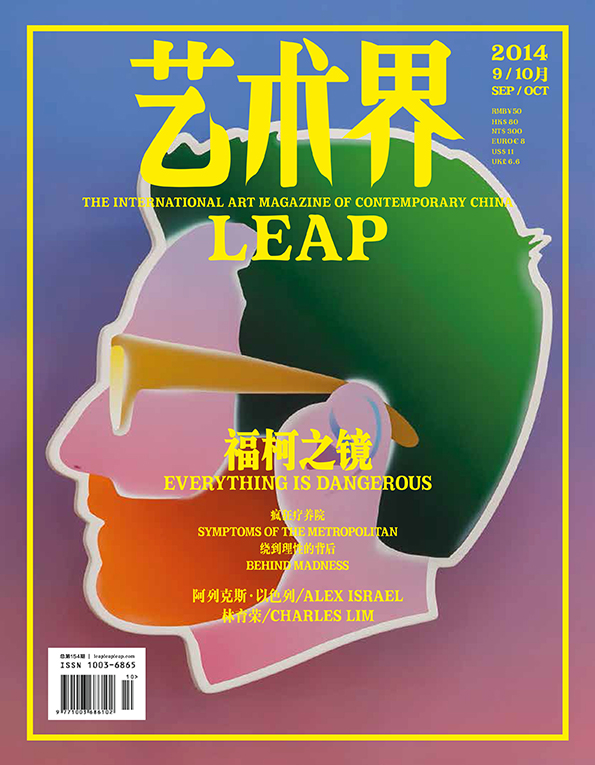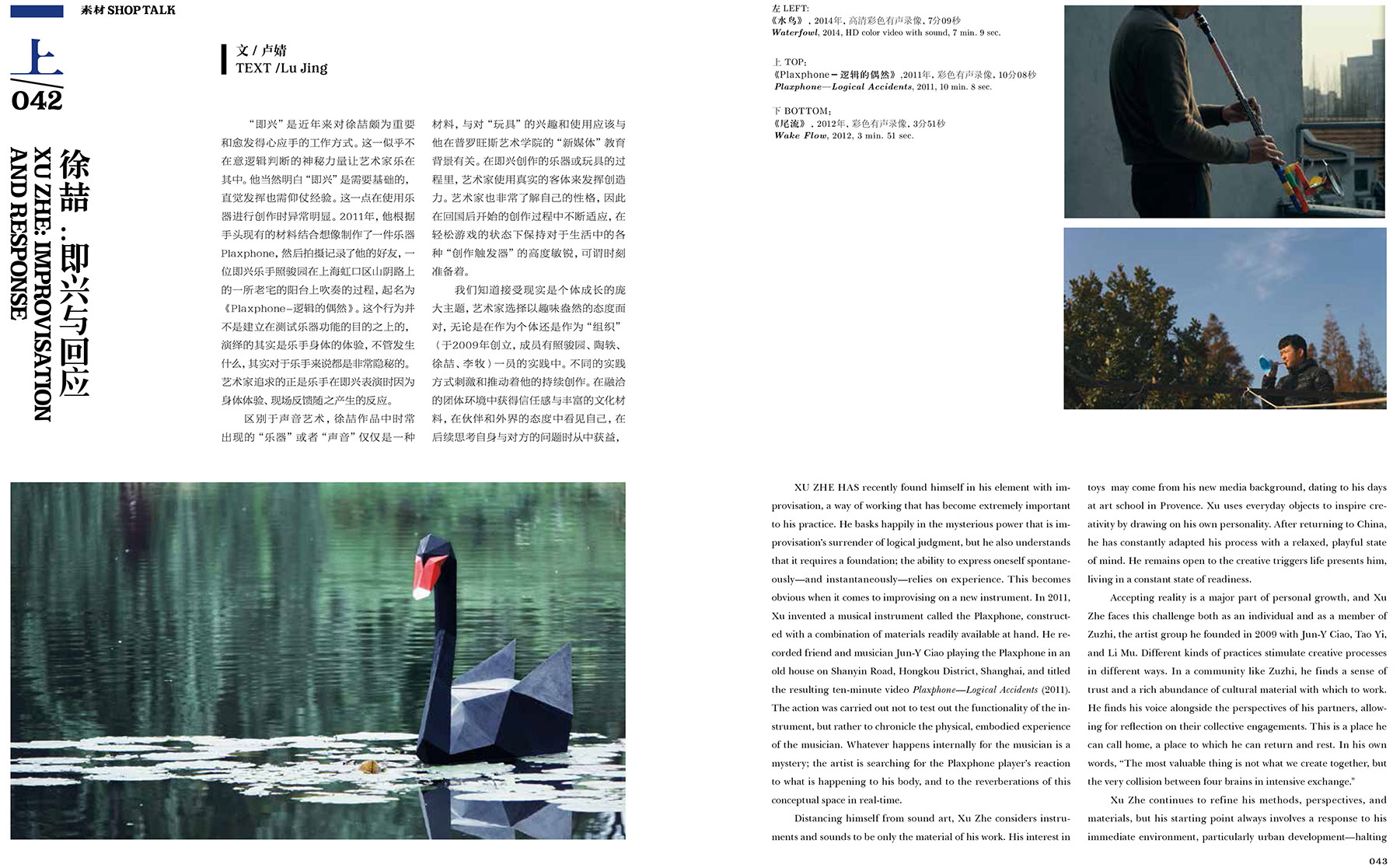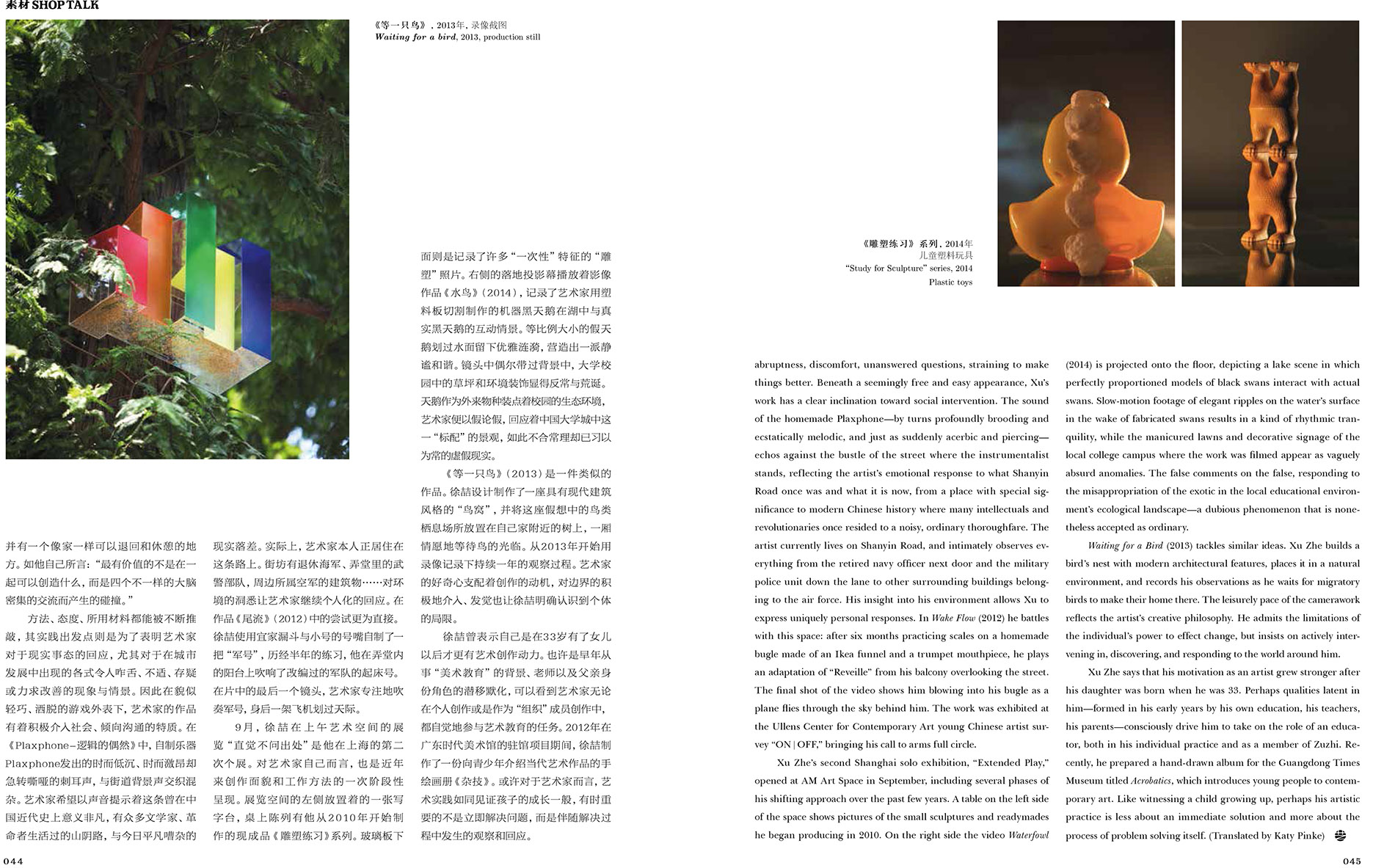2014
徐喆:择木而栖 文:陈玺安
理想的符号
艺术家在面对世界时,如何找到属於自己的视角?一个徐喆式的回答可能是扮成业余的鸟类学家。比起艺术家而言,在工作之余对鸟类所产生的爱好,可能更有一种非社会性,并且离现实更为遥远,毕竟人们对这个无关乎利益,并且对鸟类世界充满热情的小圈子知之甚少。在这边,鸟类学家几乎就只是个符号。而在徐喆的艺术实践中,他便常常占用一些特别的,类似于鸟类学家的位置,从而突出一些往往在美学上充满可塑性的符号。而这种符号也经常为他带来超越现实的诗意,并且表达了一种执拗的专注和热情。
上个夏天,徐喆第一次将他对鸟的热情转化成作品,放在群展《太阳》中。艺术家挂在柱子上的屏幕让人稍微要仰起头来看,高度有点像是这部纪录片中鸟屋被安置在树上的位置。这个依据现代主义美学所制作的鸟屋给艺术家放在山阴路工作室窗外的花园;透过窗户,他用一年的时间拍摄鸟群与它们的理想栖地之间的互动。虽然这件作品的大量时间总是耗费在等待和观察上,但这个特性其实是内在于徐喆的工作方法中的。我们甚至可以说,徐喆的艺术往往是以等待和观察来被定义的。这种对事物保持距离的态度,说起来是对一个理想美学对象的守候;但,这却跟人们在赏鸟帐中的静待不大相同:他看上去并没有打算要在现实中盼到什麽。因此,等待更像是种强调出此物缺席的语气。而这种缺席於是把一个实实在在的对象架空,正是透过这个过程,鸟变成一种非现实的符号在作品中流动。
缺席
这种在现实中强调一件事情不存在的语气,常以不同的形式出现在徐喆的创作中:譬如,在《尾流》这段声音表演中,他站上老式洋房的最高处,面对空中不真正有观众的一个方向,自顾自地吹起组装过的号角。另一种徐喆喜欢指出的空缺,则体现在近期无题摄影中几近无人称的视角:徐喆采集城市中不知名的纹路,但他的取景让这些画面中的比例尺缺席,连带地,我们也因此无法确知这些微观的城市表面在现实中的具体尺寸。而在去年完成的《颠波点》中,他也多少指出了多伦路路面已经被替换掉的较为平滑的地砖。他用改造过的童车推行在翻新後的台阁路。而其作品标题所谓的颠簸对艺术家来说是一种绘画的动力来源。简单的推动童车,画纸就会被点上重复得几近偏执的笔触。
这件作品同样是艺术家於生活区左近所制作的作品。虹口区,徐喆许多作品都在此制作。也许因为徐在创作中常常面对十分熟悉的地方,他总是再三琢磨。这种慢让我们可以联系上其创作上如同绕远路一般的路径,像是《颠波点》中,力量从路面转换到童车再到画笔、纸面上的远路。同样地,他的作品与其中的地缘特质之间的关系总不是直接的,或者放大来说, 总是使用一种不轻易让人联想的方式设定其作品中符号运作的轨迹。另一方面,他的实践中也常带有远离高端科技、远离奇观的特质,其中隐隐有种法式的“道”(detournement)态度。
栖息地
有时候,你会觉得他所有的自制玩具都像是些有自己个性的小生物,而这些以便宜材料制成的小型装置往往与环境格格不入。譬如,在《尾流》和《等一只鸟》等录像中,其声响或装置就像是艺术家硬生生安插进一个与这些艺术看似无关的环境中的。另一方面,这些环境也总是对这些异物的介入有所反馈——其反馈并不总是直接的。像是另一件拍摄艺术家自制乐器如何被演奏的录像《Plaxphone》就透过影像的暗示,让人隐隐觉得街道上的车流声是回应着照骏园的乐声;而在一个艺术杂志所委托制作的计划《玩具门诊》中,徐喆则将煮软的意面条缠上缺了一个左前轮的玩具F1赛车。而盯着这件摄影久一点,则会发现反倒是玩具赛车回过头来赋予意面条一种橡皮圈的质感。在这个例子里面,我们也可以说,玩具F1赛车是意面条暂时的居所。艺术家他对於自己住处左近的观察自是不在话下,但,这种观察并不是一种最终在作品上回答问题的艺术家调查,而是更广泛意义上择木而栖的思考。这种对於栖地的想像、观察与热情,也促使徐喆注意到上个世纪之交,英国业余建筑师Ebenezer Howard的工作;他在工业时代的伦敦,打算创造一个理想宜居的“花园城市”,而徐喆透过放大临摹的方式,画了一幅Howard著作中十分重要的图表《三个磁极》。作为一个规划者,其图表强调城乡结合部的宜居,也是花园城市的理论基础。而徐喆近身摹傚,其完全贴合的视角是出自于其同作为观察者、以及创造一个理想环境的热情。
在创作活动中,这种理想环境的创造,意味着创造一个不同的视角与站位;形象化地说,徐喆的这种视角是从藏身的赏鸟屋里面往外看向世界的(一个透视学中消失点的位置)。这样的世界也因此是一个局部的世界,与地方(locality)有关。这可能是具体的工作室周边,以至於几条街道外。徐喆甚至将这种站位的行动挪到了书面上:有一次,他在与上海有关的文学作品中找灵感,便顺势把胡风的《上海是一个海》用一种迂回且个人化的方式再转译成为一片抽象的插图。其中,必要的等待与观察创造了艺术家思考的空间。这种与一般艺术生产节奏根源性的差异,标识了徐喆观察与创作的方法。而为了保证这种思考的自由度,这位虹口区的艺术家持续在他的作品中,打造与发现他自己的一个理想居所,一个花园城市。
2011
"Lost Horizon" by Carol Carter/ www.chinaphotoeducation.com
Xu Zhe was born in Shanghai in 1976. He graduated from the School of Fine Art, Aix-en-Provence, France in 2006 and now lives in Shanghai.
Xu Zhe is a very diverse artist in his practice. He works making video, installations, sculpture and photography. He is a member of an artists’ group “Zuzhi” that supports different art-related projects and he is part of a jazz improvisation band and teaches new media at Shanghai Visual Art School.
He describes himself as an artist, not particularly a photographer. Photography is a tool that he uses if he needs to express his intention.
Xu Zhe’s series “Lost Horizon”, 2010, was inspired by Hungarian director Béla Tarr's film style (dark, atmospheric, in black and white) and British author George Orwell's novel "Animal Farm". He had read a Chinese translation of “Animal Farm” and was amazed at the words of Orwell. The novel is a satire of totalitarian governments in their many guises and Xu Zhi draws a similarity to the Communist government of today’s China.
“This is the reality of today…we are living this today. Every image in the series has a point of reference with this reality.”
The work is a series of twelve images that are all almost black with strong chiascuro and silhouettes of animals emerging from the darkness. There are outlines of buildings, shadows cast by trees and the wire frame of a shopping trolley. The sharp teeth and staring eyes of a dog look out from the blackness. This is a narrative, however, the story can only be imagined. The visual reference to the animals makes a connection with Orwell’s text. Neither the sequence of the series, the content or the composition of the photographs matches Orwell’s story, however, the negative emotion and the sinister nature of the plot is imagined in the works. Xu Zhe produced a video of the stills to add another dimension to the work. The video includes some animation techniques to give some movement to elements like clouds.
To make this work Xu Zhe constructs a “tableau”. This is a set with props and models, which he lights very simply. The lighting is from below the surface of a glass table with additional small lights to give form to the objects. The objects, like the toy animals, are collected or purchased from the internet. Xu Zhi also combines existing photographs of real things, such as clouds, to add to the narrative of the tableau.
The photographs are taken with a digital camera that is hand-held. This adds some distortions caused by movement, blurring and softening the image. The images are quite sinister and threatening and suggest a violent society that has lost control.
消失的地平线 --樊 林
“消失的地平线”系列作品的原典是《动物农场》!这个令人兴奋、躁动的事实在画面以布景和角色的方式出现时,就迅速地确立了我感受徐喆的方式。
要知道,“乔治·奥威尔(GeorgeOrwell)”在我的阅读词汇表中属于找寻同伴的暗号一类。《一九八四》种在内心多年,已然参天大树;更多的时候,当我嗅到某些隐藏着的质疑、悲伤的宿命感,就喜欢以《动物农场》来试探那些可能本质上一致的对象;新近译过来的《上来透口气》代表着奥威尔文字形象的另一面,怀旧、幽默,但依然保持着奥威尔独特的敏锐和哀伤,同样成为与某些人对接的话题。第一眼见到徐喆的“消失的地平线”,熟悉的“味道”扑面而来,我的喜悦可想而知。 然而,当作者表示自己并非如我一般阅读奥威尔多遍,原典仅仅是画面的线索之一,我开始警惕并修正自己的角度,发现徐喆具有一种与众不同的本领,我愿意将这种能力概括为他的“擅长弱化”。一方面,他承认自己受贝拉·塔尔(BélaTarr)电影美学与乔治·奥威尔《动物农场》的启示,另一方面——也是更重要——的事实在于:他迅速抛出了个人创作的线索,令人信服地看到故事本身其实已经消解在场景中。系列作品的结构、每一个画面的具体呈现均不顺应《动物农场》的故事发展,抽离现实依据,却与本质的荒谬、恐怖、否定如出一辙。 这样的贴近本质的能力几年前已经开始贯穿在徐喆的创作中。他曾经完成过一件装置作品,以电路板和其他电子零件构成的“啄木鸟”在温情地发出它的声响,徐喆利用了新技术、新媒介时代的叙事方式怀想关于童年的记忆。他不是文学青年,但是他在创作中想到过余华的《兄弟》里的少年搂着电线竿聆听电流声的细节。这些阅读——无论文字或者图像方面——令徐喆在结束法国的求学之后,单刀直入地以一种独特的个人方式开始了他的叙事。在弱化他人影响的同时,徐喆开始强化自己的方式,“消失的地平线”应该属于比较清晰的一个结点。
用纪实摄影的方式虚构一个令人信服的地理环境,用相机“记录”下其中正在发生的情境。当虚构的画面以想象、记忆片断性地组合或者叠加,每一个观者得到的将是关于荒谬的最强烈的叙述。这正是徐喆想强调的:世界应该颠倒过来看,才会更加清楚。颠倒过来看世界的,最著名的有德国新表现主义者乔治·巴塞利兹,以倒置形象描绘人物,在画布上肆意而狂放的倒置肖像成为他的代表性方式。巴塞利兹的叙事方式不属于现实主义的提炼,他提供的是充满怪异乖张情绪的现代人的写照。“新表现主义”在叙事方式上,继承了表现主义的个人化特质,更进一步导向了反传统审美标准的立场,并渐渐呈现出坚定的姿态。某种意义上讲,徐喆正在进行的也是这样的一件事情,尽管他的表达并非图像上的颠倒处理。
以摄影为创作手段的艺术家必定遭遇地域特征的问题,这与相机镜头的第一功能——捕捉对象——具有天生的关联,当然这里“地域特征”所指比较大而化之,即场景、人种、文化等等。即便是在人为环境中创作的影像,人们也倾向于从辨认这些特征开始欣赏作品。徐喆的强烈在于:无论是对象的特征还是方式上的特征,仿佛都不在他的考虑之中。因此,他有一部分场景的处理是添加了一些我们能够感受到的时代特征,得以与奥威尔在精神上产生神奇的契合。
从本质上看徐喆的创作,即有乔治·奥威尔的影响,也有卡尔维诺的影响,但他都以不依照的方式进行了特殊的弱化,直到那些属于徐喆的语汇浮现出来。这时候,颠倒更加直接、强烈地等同于否定。
Lost Horizon--Fan Lin
‘Lost Horizon’ originates from ‘Animal Farm’! This excitement and restlessness pictured itself in the forms of settings and roles, soon determines my way to appreciate Xu Zhe’s works.
In my vocabulary, ‘George Orwell’ belongs to certain codes needed when I am looking for comrades. ‘1984’ planted deep in my heart for years, has grown into a towering tree. Mostly when I smell an indistinct sad and doubtful foreordination, I would detect the possible accordant with ‘Animal Farm’; the newly translated ‘Coming up for Air’ represents another side of Orwell’s verbal image, which is nostalgic and humorous but still maintains Orwell’s characteristic acuity and grief. That has also become the topic that links certain people up. At the first sight of Xu Zhe’s ‘Lost Horizon’, a familiar ‘smell’ surged and I was overwhelmed by joy.
However, when the author said that he hadn’t read Orwell’s works as many as I had and the original was only one clue of the photographs, I began to be vigilant and correct my point of view. Then I found Xu Zhe has a distinctive talent which I would like to summarize as ‘weakening’.
On one hand, he admits that he is inspired by Béla Tarr's movie aesthetics and George Orwell's novel 'Animal Farm'; on the other hand and more important, he quickly reveals the clue of his creation, which convinces people that the story itself has been dissolved in the scenes. Neither the structure of the series nor the composition of a single photo follows the plot of ‘Animal Farm’. Although divorced from reality, the series is essentially as absurd, horrible and negative as the story.
This capacity of approaching the essence has run through Xu Zhe’s works for many years. He once made an installation of a ‘woodpecker’ composed by circuit boards and other gears which peck in a tender sound. Xu Zhe, with the expressions of the new technology and new medium time, yearns for childhood memory. He’s not a literary youth but in his work, he recalls one detail in Yu Hua’s ‘Brothers’ that a teenager holds a telegraph pole listening to the sound of the current. No matter word or image, these readings help Xu Zhe start narration straight to the point in an individual way after his study in France.
While weakening others’ influences, Xu Zhe begins strengthening his own style. ‘Lost Horizon’ shall be regarded as a prominent land mark.
Xu Zhe fabricates a convincing geographical environment with documentary photography and 'records' the happenings with the camera. As fictive pictures are combined and overlapped by imaginary and memorial fragments, what each audience receives is the most intense expression of absurdity. The world shall be more evident when seen in reverse. This is exactly what Xu Zhe wants to emphasize. Among those who see the world in reverse, German Neo-Expressionist Georg Baselitz is the most famous for upside-down images. The characteristic style of his painting is to recklessly invert portraits on canvases. Portraying the eccentric emotions of the modern people, Baselitz’s expression doesn’t belong to any extraction of realism. The Neo-Expressionism adopts the individual style from the Expressionism in ways of expression, further leads to the position against the traditional aesthetic standards and gradually shows a firm attitude. In some way, Xu Zhe has been carrying on the same thing despite that the images are not upside-down.
The artists working with cameras are bound to encounter the problems of geographic locations, which is naturally connected with the fist function of a camera lens: capturing an object. Of course, the ‘geographic locations’ cover a wide range of features including scenes, races and cultures, etc. Even when looking at photographs created in an artificial environment, people tend to start appreciating the works from recognizing these features. Xu Zhe seems not to take any feature into account no matter from object or method. This is why his works feel intense. Therefore, he adds some acquainted features of our time in some scenes so as to mentally and magically accord with Orwell.
Essentially in Xu Zhe’s works, we can find influences from both George Orwell and Italo Calvino, but he doesn’t follow their ways. Instead, he specially weakens their touches till his own style emerges. At this point, reverse is so direct that it strongly equals to negative.
Translated by Fanchen


